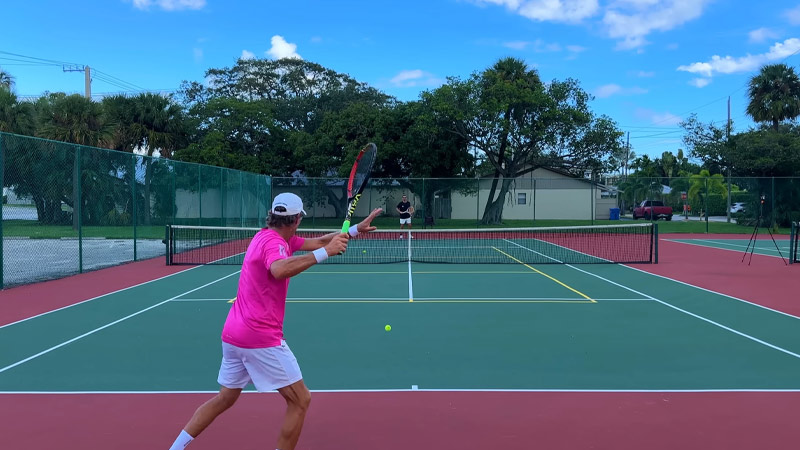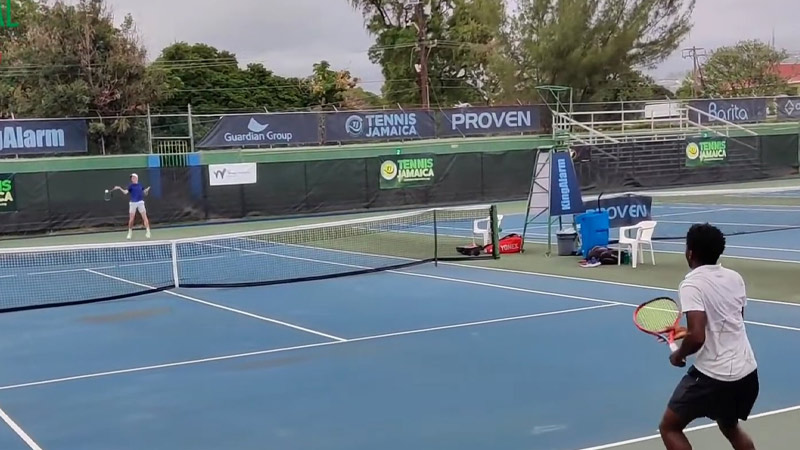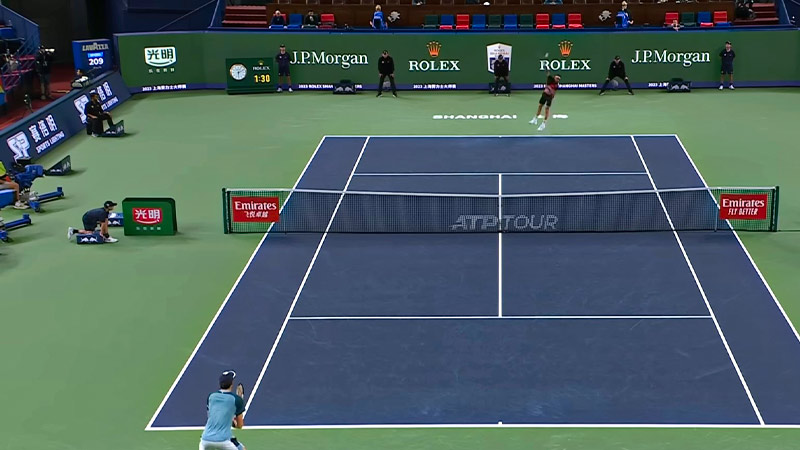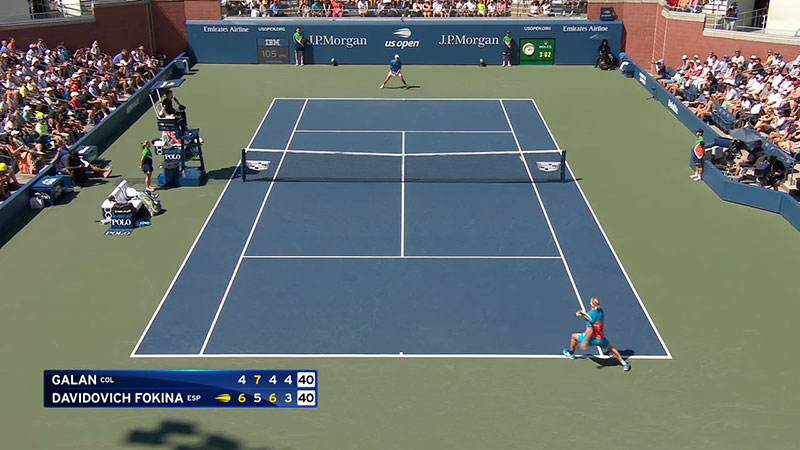In the dynamic world of professional tennis, rankings play a pivotal role in determining a player’s status and trajectory in the sport. Traditional rankings like those provided by the ATP and WTA offer a real-time snapshot of a player’s performance.
There is another ranking system that often goes underappreciated but is of utmost importance in ensuring fairness and opportunity: the Protected Ranking, or PR in tennis.
In this blog post, we delve into the world of tennis rankings to demystify what does PR mean in tennis draws and why it matters.
PR is not just a collection of letters but a lifeline for players who have faced extended absences due to injuries or other exceptional circumstances.
It levels the playing field, safeguards comebacks, and enriches the tournament experience for players and fans alike. Let’s explore the significance of PR in tournament draws and its impact on the sport’s competitive landscape. So, stay focused.
What Does PR Mean in Tennis Draw?
In tennis, “PR” typically stands for Protected Ranking. A Protected Ranking is a special ranking that is assigned to a player who has been unable to compete for an extended period of time due to injury or other exceptional circumstances.
When a player is unable to compete for a significant amount of time (usually six months or more) due to injury or illness, they can apply for a Protected Ranking from the ATP or WTA, depending on their gender.
This PR in tennis is based on their average ranking points over a specified period before their injury or absence.
The player can then use this Protected Ranking to gain direct entry into tournaments or potentially receive a higher seeding.
The purpose of a Protected Ranking is to give players who have been sidelined a fair opportunity to return to competitive tennis without being penalized for their absence.
It helps them avoid starting from scratch and potentially facing tougher opponents in early rounds.
Factors Influencing PR in Tennis Draws

The Protected Ranking (PR tennis abbreviation) in tennis draws is influenced by several factors, mainly related to a player’s inability to compete for an extended period due to injury or exceptional circumstances.
Here are the key factors that influence a player’s PR in tennis draws:
Injury or Illness
The primary reason for being granted a PR in tennis is an injury or illness that has kept the player off the tour for a substantial period, typically six months or more.
This injury or illness should be verified and documented by medical professionals.
Application Process
Players must apply for a PR in tennis through their respective governing bodies, such as the ATP (Association of Tennis Professionals) for male players and the WTA (Women’s Tennis Association) for female players.
The application process usually requires medical records and a detailed explanation of the injury or illness.
Historical Ranking
The PR is based on a player’s historical ranking before the injury or absence. It typically considers the average ranking points earned by the player during a specific period leading up to their absence, often 12 or 18 months.
Length of Absence
The length of time a player has been absent from competition is a critical factor.
To qualify for a PR, a player must meet the minimum absence requirement, which is typically six months but may vary slightly depending on the governing body’s rules.
Number of Tournaments Played
Some organizations may consider the number of tournaments a player participated in during the qualifying period.
If a player competed in only a limited number of tournaments due to injury or illness, it can affect the calculation of their PR in tennis.
Previous PR Usage
Players are generally allowed to use their PR for a limited number of tournaments or a specific duration.
The rules regarding PR usage can vary, but typically, a player can use it for a maximum of 12 months or until they reach a certain ranking.
Tournament Entry and Seeding
Once a player is granted a PR, they can use it to gain direct entry into tournaments and potentially receive a higher seeding.
The specific rules regarding how PRs are used in tournament draws may vary from one governing body or tournament to another.
Return to Competition
A player’s PR is often valid until they have played a certain number of tournaments or reached a specified ranking threshold.
Once they meet these criteria, their PR in tennis draw is no longer in effect, and they return to using their current ranking for tournament entry and seeding.
It’s important to note that the exact rules and criteria for PRs may differ between the ATP and WTA, and they may change over time.
Significance of PR in Tournament Seeding

The Protected Ranking (PR) plays a significant role in tournament seeding in professional tennis.
Seeding is the process by which players are ranked or placed in a tournament draw, with the top-seeded players receiving favorable positions. Here’s the significance of PR in tournament seeding:
Fairness and Competitive Balance
The primary significance of PR in seeding is to ensure fairness and competitive balance in tournaments.
When a player has been sidelined due to injury or illness for an extended period, their current ranking may not accurately reflect their true skill level.
Using their PR instead of their current ranking can result in a more equitable seeding, preventing them from facing top-ranked players in the early rounds and giving them a better chance to perform well.
Protection for Returning Players
PR in tennis allows players who have been injured or absent from the tour to return to competition with a degree of protection.
It acknowledges their prior achievements and provides them with a more advantageous position in the draw based on their historical performance, rather than penalizing them for their time away from the sport.
Encouragement for Comebacks
PR can serve as an incentive for players to make comebacks after injuries.
Knowing that they will have a higher seeding and potentially face lower-ranked opponents in the early rounds can motivate players to work hard in their rehabilitation and return to the tour.
Enhanced Tournament Quality
By using PR for seeding, tournaments can maintain a high level of competition.
Players with PRs are more likely to be competitive and provide exciting matches, which can be beneficial for the tournament’s overall quality and entertainment value.
Higher-Quality Early Matches
Seeding based on PR in tennis can lead to more competitive early-round matches. Instead of top-seeded players facing weaker opponents in the early stages of the tournament,
PR seeding can result in stronger matchups from the outset, which can be appealing to fans and television audiences.
Reduced Upsets
PR seeding can reduce the likelihood of early-round upsets caused by strong players facing each other prematurely due to their lower current rankings.
This can make the tournament more predictable and align with fans’ expectations.
Player Confidence
Players returning from injury or illness may have greater confidence knowing that they are not immediately pitted against the top-ranked players. This can contribute to their successful return to competitive play.
It’s worth noting that the specific rules and procedures for using PR in tennis tournament seeding can vary between different governing bodies, such as the ATP and WTA, as well as individual tournaments.
PR vs. Traditional Rankings

PR (Protected Ranking) and traditional rankings are two different methods of assessing a tennis player’s standing in the sport. Each has its own purpose and significance:
Traditional Rankings
- Traditional rankings, such as the ATP (Association of Tennis Professionals) rankings for male players and the WTA (Women’s Tennis Association) rankings for female players, are based on a player’s recent performance in professional tournaments.
- These rankings consider the points earned by players in various tournaments over the past 52 weeks. Points are awarded based on the round reached in each tournament and the tournament’s category (e.g., Grand Slam, Masters 1000, 500, 250, or International).
- Traditional rankings provide a current and up-to-date assessment of a player’s performance in the sport.
- Players’ traditional rankings are used for determining their acceptance into tournaments, their seeding within those tournaments, and their eligibility for various tour events.
PR (Protected Ranking)
- PR, or Protected Ranking, is a special ranking used in cases where a player has been unable to compete for an extended period due to injury, illness, or other exceptional circumstances.
- PR is based on a player’s historical performance and ranking before their injury or absence from the tour.
- It is used to provide a player with a more favorable tournament draw and seeding when they return to competitive play after an extended absence.
- PR is a temporary ranking that allows the player to gradually reintegrate into the tour without facing the same level of competition they might have faced if they were solely using their current ranking.
Key Differences
- Traditional rankings reflect a player’s current form and performance, while PR reflects their historical performance.
- Traditional rankings are continuously updated every week, while PR is used on a temporary basis and is typically valid for a specific number of tournaments or a limited duration.
- Traditional rankings are used for most tournament entries and seeding, whereas PR is specifically designed to assist players returning from injury or prolonged absence.
- PR is a tool for fairness and protection, ensuring that players who have been sidelined are not unduly penalized when they return to competition.
Impact of PR on Matchups and Tournament Dynamics
The use of Protected Rankings (PR) in tennis can have a significant impact on matchups and tournament dynamics. Here’s how PR can influence these aspects of the sport:
Matchup Quality
- PR can lead to higher-quality matchups, especially in the early rounds of tournaments. When players returning from injury or extended absence use their PR for seeding, they are often placed in positions where they are less likely to face top-seeded players right away.
- This means that players with PRs may encounter more evenly matched opponents in the early stages of tournaments, leading to more competitive and exciting matches.
- Fans and spectators may see fewer lopsided matches in the initial rounds, which can enhance the overall viewing experience.
Competitive Balance
- PR in tennis helps maintain a level of competitive balance in tournaments. Players who have been away from the sport due to injury or illness are not immediately thrown into highly competitive situations, which can be detrimental to their confidence and performance.
- Instead, PR allows them to gradually reintegrate into the tour, compete against opponents closer to their skill level, and build up their form and confidence.
Seeding Effects
- PR can affect the seeding of players in tournaments. When players use their PRs for seeding, they may receive higher seedings than their current rankings would suggest.
- This can influence the overall tournament dynamics, as players with PRs may be placed in different sections of the draw compared to where they would be seeded based solely on their current ranking.
- PR seeding can prevent top players from facing each other in the early rounds, potentially leading to more competitive later stages of the tournament.
Upset Potential
- PR seeding can reduce the likelihood of early-round upsets caused by strong players facing each other prematurely due to their lower current rankings.
- While upsets are a part of sports, PR seeding can make tournament outcomes more predictable in the early rounds, aligning with fans’ expectations and reducing surprises.
Player Comebacks
PR can encourage players to make successful comebacks after injuries or extended absences.
Knowing that they will receive favorable seeding and matchups based on their historical performance can motivate players to work diligently on their recovery and return to competitive play.
Fan Engagement
The use of PR in tennis can enhance fan engagement by offering more compelling and competitive matches.
Fans are more likely to be excited about tournaments when they anticipate competitive contests rather than one-sided affairs in the early rounds.
It’s important to note that the impact of PR on matchups and tournament dynamics may vary depending on the specific tournament.
Also, the rules and guidelines of the governing bodies (ATP or WTA), and the duration and number of tournaments for which a player is allowed to use their PR in tennis.
FAQs
What Is PR tennis meaning?
PR in tennis stands for “Protected Ranking.” It is a specialized ranking system used to assist players who have been sidelined due to injury or exceptional circumstances.
PR in tennis allows these players to have favorable tournament draw positions and seedings when they return to competitive play.
What does pr stand for in tennis?
In tennis, “PR” stands for “Protected Ranking.” This ranking is based on a player’s historical performance and ranking before an extended absence, often due to injury or illness.
PR is used to provide returning players with fair and competitive tournament draw positions and seedings.
How is PR calculated in tennis?
PR in tennis is calculated based on a player’s average ranking points earned over a specified period before their injury or absence from the tour.
The specific calculation method may vary between governing bodies, but it generally considers the player’s performance during that timeframe.
How long can a player use their PR in tennis?
The duration a player can use their PR in tennis varies but is typically limited.
Players are often allowed to use their PR for a maximum of 12 months or until they reach a specific ranking threshold, whichever comes first. The exact rules may differ between governing bodies.
Why is PR important in tennis draws?
PR is essential in tennis draws because it ensures fairness for players returning from injuries or extended absences.
It helps protect their competitive opportunities by providing them with favorable draw positions and seedings based on their historical performance, preventing them from facing top-ranked players immediately.
Wrapping Up
In the world of tennis, where injuries and setbacks are part and parcel of the journey, PR stands as a beacon of hope.
It ensures that even when life sidelines a player, their past accomplishments are acknowledged, and their return to the court is met with fairness and respect.
As we conclude our exploration of what PR in tennis draws means, it’s evident that this protective ranking is not just a statistic.
Even, it’s a testament to the resilience of athletes and the commitment of the sport to provide equal opportunities to all who wield a racket.
Whether you’re a player aiming for a comeback or a fan eagerly anticipating competitive matches, PR remains a vital and cherished component of the tennis world. Thank you so much.







